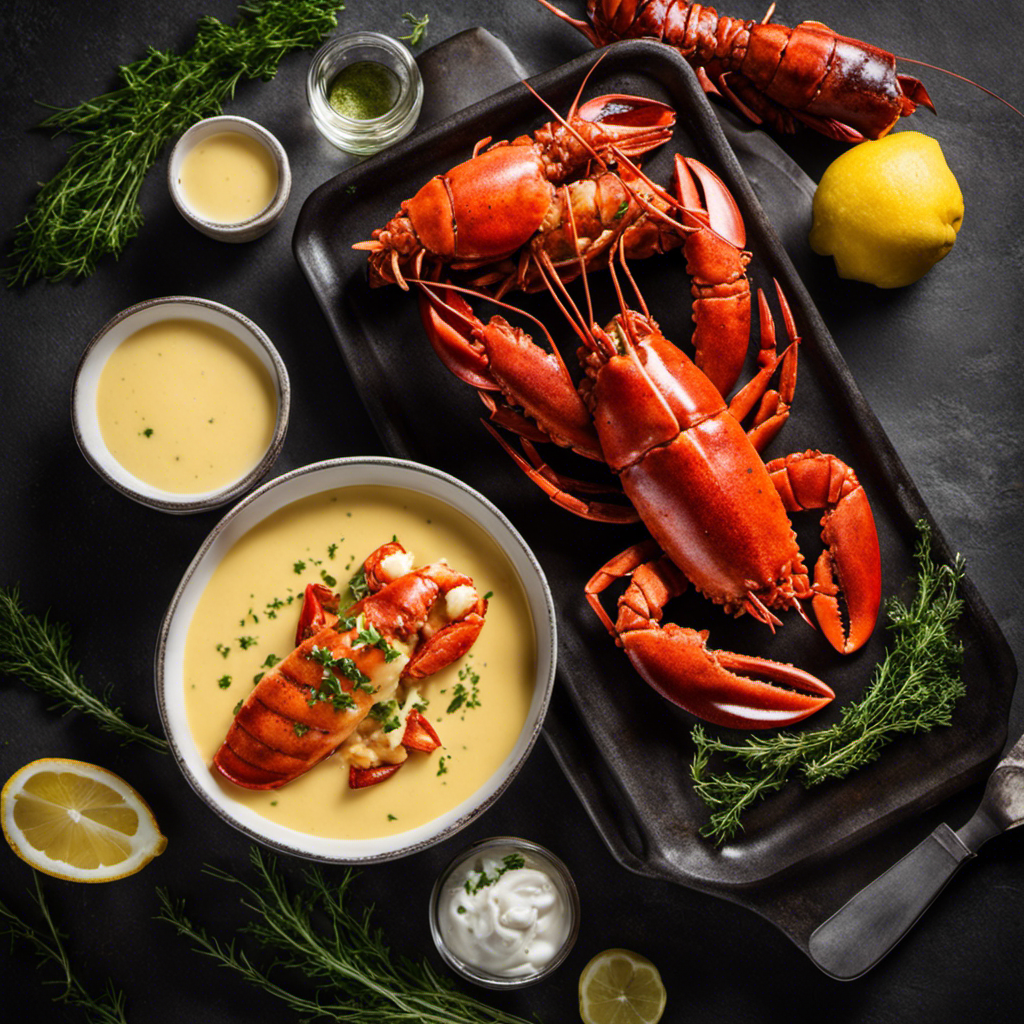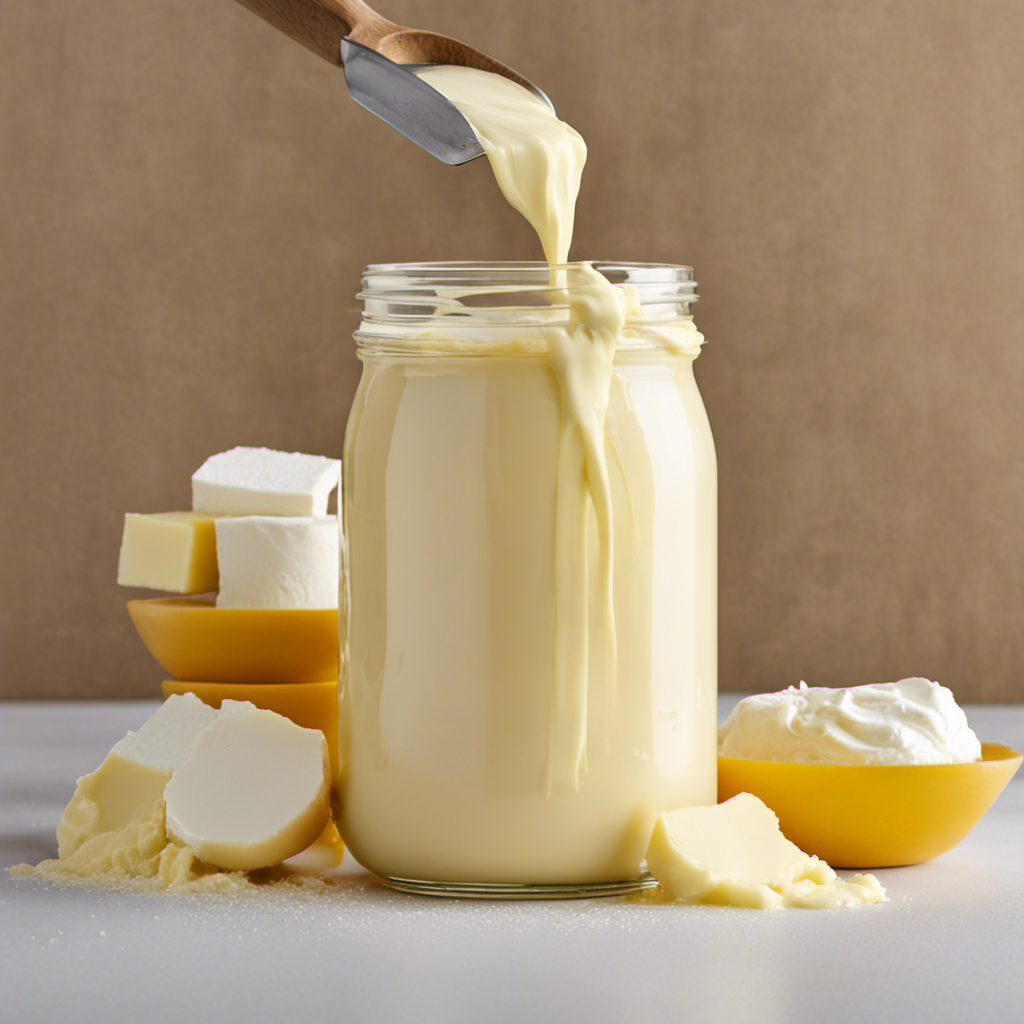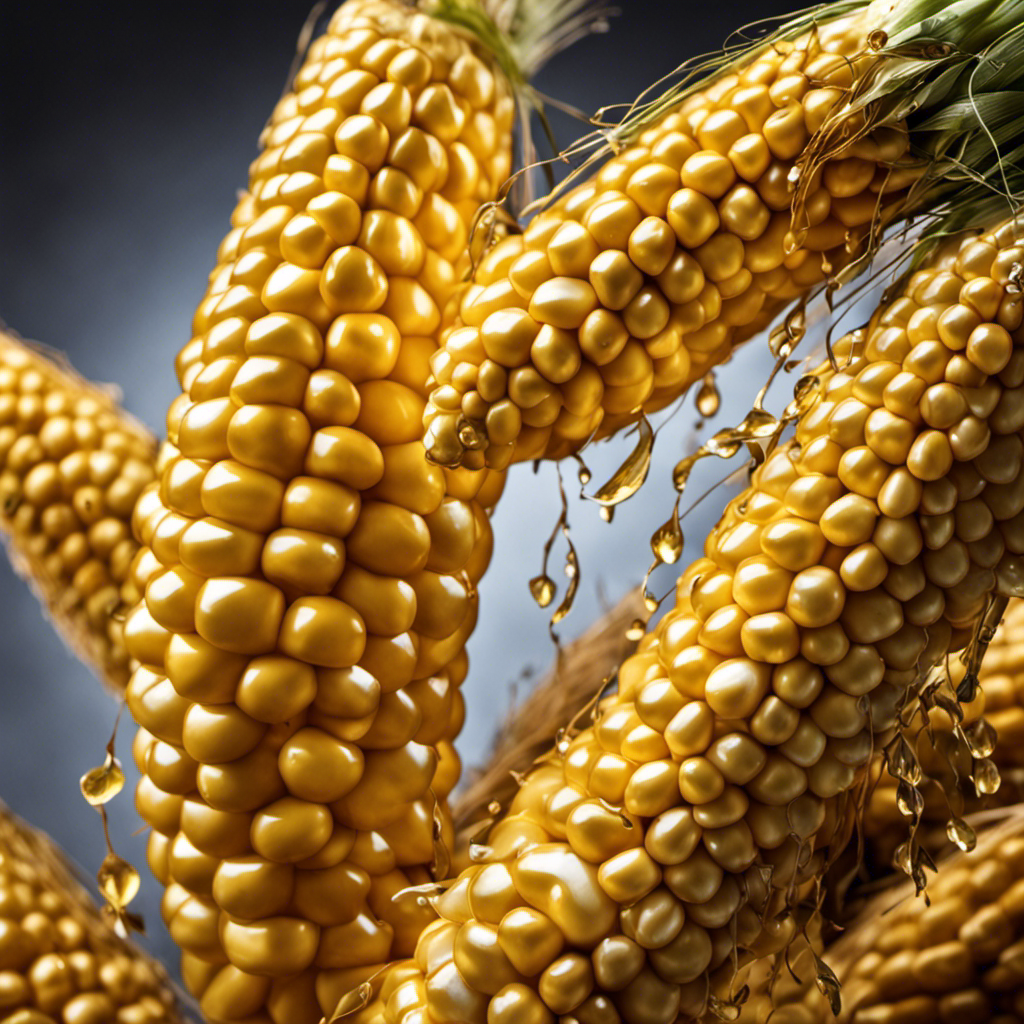Recipes & Culinary Uses
The Kind of Cream You Need to Make Homemade Butter
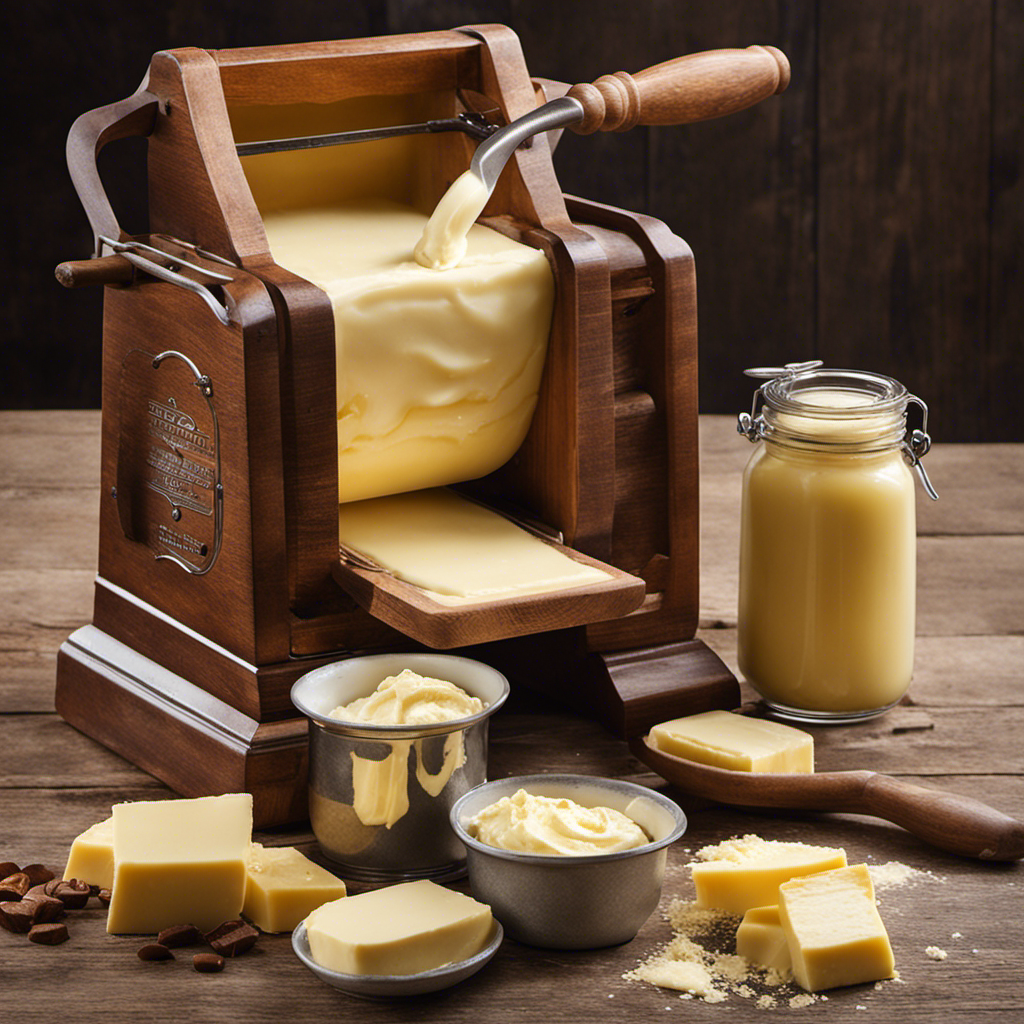
As a home cook, I’ve always believed that the key to excellent butter lies in the cream used to create it. Selecting the proper type of cream can truly elevate the richness, smooth texture, and irresistible taste.
In this article, I’ll guide you through the various types of cream for butter making, from fresh to pasteurized, heavy to whipping, and even non-dairy options.
So, let’s dive in and discover the cream that will elevate your homemade butter to a whole new level of deliciousness.
Key Takeaways
- Heavy cream and whipping cream are suitable for butter making, with heavy cream resulting in a richer and creamier butter and whipping cream resulting in a lighter and milder tasting butter.
- Fat content is crucial for making butter, with higher fat content cream producing a higher yield of butter.
- Freshness of the cream is important, as cream that has been sitting for too long may have a sour taste.
- Cream quality matters, so opt for fresh cream from grass-fed cows that is thick, slightly sweet, and a rich, creamy white color for the best taste and texture in homemade butter.
Types of Cream for Butter Making
To make butter, you’ll want to use heavy cream or whipping cream. Both types of cream are suitable for butter making, but there are factors to consider when choosing which one to use.
Taste is an important consideration when making butter. Heavy cream typically has a higher fat content, which results in a rich and creamy butter with a stronger flavor. On the other hand, whipping cream has a slightly lower fat content, resulting in a lighter and milder tasting butter.
Safety considerations are also important when selecting cream for butter making. It is crucial to choose cream that is fresh and free from any contaminants. Look for cream that is pasteurized to ensure it is safe to consume.
When choosing cream for making butter, consider the taste you desire and the safety of the cream. These factors will help you make the best choice for your butter making endeavors.
Factors to Consider When Choosing Cream
When choosing cream, it’s important to consider factors such as fat content and freshness. The fat content in cream is crucial for making butter. Cream with higher fat content, usually labeled as heavy cream or whipping cream, is ideal for butter making as it produces a higher yield of butter.
On the other hand, cream with lower fat content, like light cream or half-and-half, may not provide sufficient fat for butter production. Additionally, the freshness of the cream is essential. Cream that has been sitting for too long may have a sour taste and affect the quality of the butter.
It’s also important to be aware of the cream processing methods, as some methods may impact the final product’s texture and flavor.
Fresh Cream Vs. Pasteurized Cream
When it comes to choosing cream for making butter, there are two main options to consider: fresh cream or pasteurized cream.
The choice between the two depends on several factors, including cream quality, taste preferences, and safety considerations.
It is important to understand the differences between fresh and pasteurized cream in terms of flavor, texture, and potential health risks before making a decision.
Fresh or Pasteurized
If you want to make butter, you’ll have to decide whether to use fresh or pasteurized cream.
Fresh cream, which is cream that has not been heat-treated, has several benefits when it comes to making butter. First, fresh cream has a higher fat content, which means that it will yield a creamier and richer butter. Second, fresh cream retains its natural flavor, giving your butter a more pronounced and delicious taste.
On the other hand, pasteurized cream, which has been heat-treated to kill bacteria, has some drawbacks. The heat treatment can alter the taste and texture of the cream, resulting in a less flavorful and slightly grainy butter. Additionally, pasteurized cream often contains additives and stabilizers, which can affect the overall quality of your homemade butter.
Ultimately, the decision between fresh and pasteurized cream depends on your personal preference and the desired outcome of your butter-making process.
Cream Quality Matters
To achieve the best results, you should prioritize the quality of the cream you choose. Cream freshness and the cream source are important factors to consider when making butter. Here are four key points to keep in mind:
-
Freshness: Opt for cream that is as fresh as possible. Fresh cream not only tastes better but also churns more easily into butter.
-
Source: Consider the source of the cream. Look for cream from cows that are grass-fed and free from hormones and antibiotics. This will result in a higher quality cream and ultimately, better butter.
-
Consistency: Choose cream with a consistent texture. Cream that is thick and slightly sweet is ideal for making butter.
-
Color: Look for cream that is a rich, creamy white color. This indicates that it is of good quality and has not been overly processed.
Taste and Safety Considerations
Consider opting for cream from grass-fed cows that are free from hormones and antibiotics, as this can enhance the taste and safety of your homemade butter. When making butter, the quality of the cream is crucial for achieving the desired taste and ensuring the healthiness of the final product. Grass-fed cows produce cream that is rich in flavor and nutrients, resulting in a more flavorful butter. Additionally, by choosing cream from cows that are free from hormones and antibiotics, you can avoid potential health concerns associated with these additives. To help you understand the importance of cream quality, here is a table summarizing the key differences between cream types:
| Cream Type | Taste | Health Concerns |
|---|---|---|
| Grass-fed | Rich, flavorful | Free from hormones and antibiotics |
| Conventional | Mild | Potential exposure to hormones and antibiotics |
| Organic | Mild | Free from synthetic fertilizers and pesticides |
Heavy Cream Vs. Whipping Cream for Butter
When it comes to making butter, understanding the ideal fat content and the different whipping properties of heavy cream and whipping cream is essential.
The fat content in heavy cream is typically higher than in whipping cream, making it more suitable for achieving a rich and creamy texture in butter.
Additionally, the whipping properties of the two creams differ, with heavy cream being able to hold its shape better when whipped.
Ideal Fat Content
The ideal fat content for making butter is typically around 82%. When considering fat content for butter, there are a few important factors to keep in mind:
-
Cream type: Heavy cream, with a fat content of around 36%, is commonly used for making butter. It provides a rich and creamy consistency. Whipping cream, with a slightly lower fat content of around 30%, can also be used but may result in a slightly lighter texture.
-
Churning time: The longer you churn the cream, the more fat separates from the liquid. This affects the final consistency of the butter. If you prefer a softer butter, churn for a shorter time. For a firmer texture, churn for a longer time.
-
Temperature: The cream should be cold when churning to ensure proper fat separation. Chilling the cream in the refrigerator before churning is recommended.
-
Quality: Using high-quality cream with a consistent fat content ensures a better end product. Always check the labels and choose cream with a fat content suitable for your desired butter consistency.
Different Whipping Properties?
If you want a firmer texture for your butter, you should churn the cream for a longer time. The texture of butter is greatly influenced by the different cream textures and the temperature at which the cream is churned.
Creams with higher fat content tend to yield a firmer butter compared to creams with lower fat content. The fat acts as a stabilizer during the churning process, resulting in a denser and more solid texture.
Additionally, the temperature of the cream also plays a crucial role in determining the final texture of the butter. Churning cream at colder temperatures promotes the formation of smaller fat globules, leading to a smoother and creamier texture. On the other hand, churning cream at warmer temperatures can result in a softer and more spreadable butter.
Organic Cream for Homemade Butter
To make homemade butter, it is recommended to use organic cream. Not only does it provide a rich and flavorful taste, but it also offers numerous benefits.
Here are some key reasons why organic cream is the best choice for making butter:
-
Healthier Option: Organic cream is free from harmful pesticides, antibiotics, and growth hormones, making it a healthier choice for you and your family.
-
Environmental Friendly: Organic farming practices promote soil health, biodiversity, and water conservation, making it a sustainable choice for the environment.
-
Better Nutritional Profile: Organic cream is known to have higher levels of beneficial nutrients such as omega-3 fatty acids, vitamins, and antioxidants compared to conventional cream.
-
Superior Taste: Organic cream is often sourced from grass-fed cows, resulting in a richer, creamier flavor that enhances the overall taste of homemade butter.
When it comes to the best cream brands for making homemade butter, look for reputable organic brands like Organic Valley, Horizon Organic, Straus Family Creamery, and Maple Hill Creamery. These brands prioritize quality, sustainability, and animal welfare, ensuring the best cream for your butter-making endeavors.
A2 Cream for Butter Making
When making homemade butter, consider using A2 cream for a creamier and more flavorful result. A2 cream is derived from cows that produce milk containing only the A2 beta-casein protein, as opposed to the more common A1 protein. This difference in protein composition can have several benefits. A2 cream is easier to digest for those who are lactose intolerant or have sensitivity to dairy. It is also believed to have a richer taste and smoother texture compared to regular cream. However, availability of A2 cream may vary depending on the region. It is important to check with local dairy farms or specialty stores to find out if A2 cream is available in your area. By using A2 cream, you can enhance the flavor and quality of your homemade butter.
| A2 Cream Benefits | A2 Cream Availability |
|---|---|
| Easier digestion | Varies by region |
| Richer taste | Check local sources |
| Smoother texture | |
Cultured Cream for Artisanal Butter
Using cultured cream instead of regular cream can add a tangy flavor to your homemade artisanal butter. Cultured cream offers several benefits when it comes to making butter. Here are four reasons why you should consider using cultured cream for your butter-making process:
-
Enhanced flavor: Cultured cream has a slightly tangy taste compared to regular cream, which adds a delightful complexity to your butter.
-
Longer shelf life: The fermentation process in cultured cream helps to increase its shelf life, allowing you to enjoy your homemade butter for a longer period.
-
Creamier texture: Cultured cream has a thicker consistency, resulting in a creamier texture in your butter.
-
Health benefits: Cultured cream contains beneficial bacteria that can aid in digestion and promote a healthy gut.
By using cultured cream, you can elevate your homemade butter to a whole new level of flavor and texture while reaping the health benefits it offers.
Goat’s Milk Cream for Homemade Butter
Did you know that substituting regular cream with goat’s milk cream can impart a unique and delightful flavor to your homemade butter? Goat’s milk cream is one of the best alternatives for those who are looking for a different taste and texture in their butter.
Not only does it add a distinct flavor, but it also offers several health benefits. Goat’s milk cream is easier to digest compared to cow’s milk cream, making it a great choice for individuals with lactose intolerance or sensitive stomachs. Additionally, it contains higher levels of essential nutrients such as vitamins A, D, and calcium.
Non-Dairy Cream Options for Butter Substitute
If you’re looking for a butter substitute, there are plenty of non-dairy cream options to choose from. And if you follow a vegan diet, there are some great alternatives out there that are both delicious and animal-free.
Here are four vegan options that are perfect for replacing butter in your favorite recipes:
-
Cashew cream: Made from soaked and blended cashews, this creamy and smooth option is versatile and works well in both sweet and savory dishes.
-
Almond cream: Similar to cashew cream, almond cream is made from soaked and blended almonds. It has a slightly nutty flavor and adds richness to your dishes.
-
Coconut cream: This creamy and luscious option is made from the thick part of coconut milk. It adds a tropical touch to your recipes and works well in desserts.
-
Oat cream: Made from oats blended with water, this option is perfect for those with nut allergies. It has a mild flavor and adds creaminess to your dishes.
With these vegan alternatives, you can enjoy the creamy texture of butter without any animal products.
Frequently Asked Questions
Can I Use Light Cream to Make Butter?
No, heavy cream is necessary to make butter. Using light cream or half and half will not yield the desired result. The higher fat content in heavy cream is what allows it to separate into butter and buttermilk.
Is It Possible to Use Sour Cream to Make Homemade Butter?
Yes, it is possible to use sour cream to make homemade butter. However, the resulting butter may have a tangy flavor. If you enjoy experimenting with different flavors in homemade butter, using yogurt can also be a great option.
Can I Make Butter Using Almond Milk Cream?
I can make butter using coconut cream or heavy whipping cream. Both options will yield delicious homemade butter. It’s important to use cream with a high fat content for the best results.
What Is the Shelf Life of Homemade Butter Made With Non-Dairy Cream?
The shelf life of homemade non-dairy butter depends on the specific recipe and storage conditions. However, using non-dairy cream to make butter can have benefits such as accommodating dietary restrictions and offering a unique flavor profile.
Can I Mix Different Types of Cream to Make Butter?
Yes, you can experiment with different types of cream to make flavored butter. By using different ratios of cream, you can create the perfect homemade butter with unique flavors and textures.
Conclusion
In conclusion, the type of cream you choose is crucial when making butter. Factors such as freshness, pasteurization, and organic options should be considered.
Heavy cream and whipping cream are both suitable choices for making butter. However, if you want a more artisanal butter with an elevated flavor profile, cultured cream is the way to go.
For a unique twist on homemade butter, consider using goat’s milk cream. It adds a distinct flavor that can take your butter to the next level.
If you prefer non-dairy alternatives, there are cream options available as well. So, don’t be afraid to explore the wonderful world of butter making and let your creativity churn out something truly delightful!
From sneaky childhood butter licks to penning some of our most popular articles, Jamie’s journey with butter has been lifelong. His culinary background gives him a unique perspective, allowing him to craft mouthwatering articles that educate and tantalize equally. Jamie’s travel adventures revolve around finding the world’s best buttery treats when he isn’t writing.
Recipes & Culinary Uses
How to Make Creamy Butter Garlic Pasta
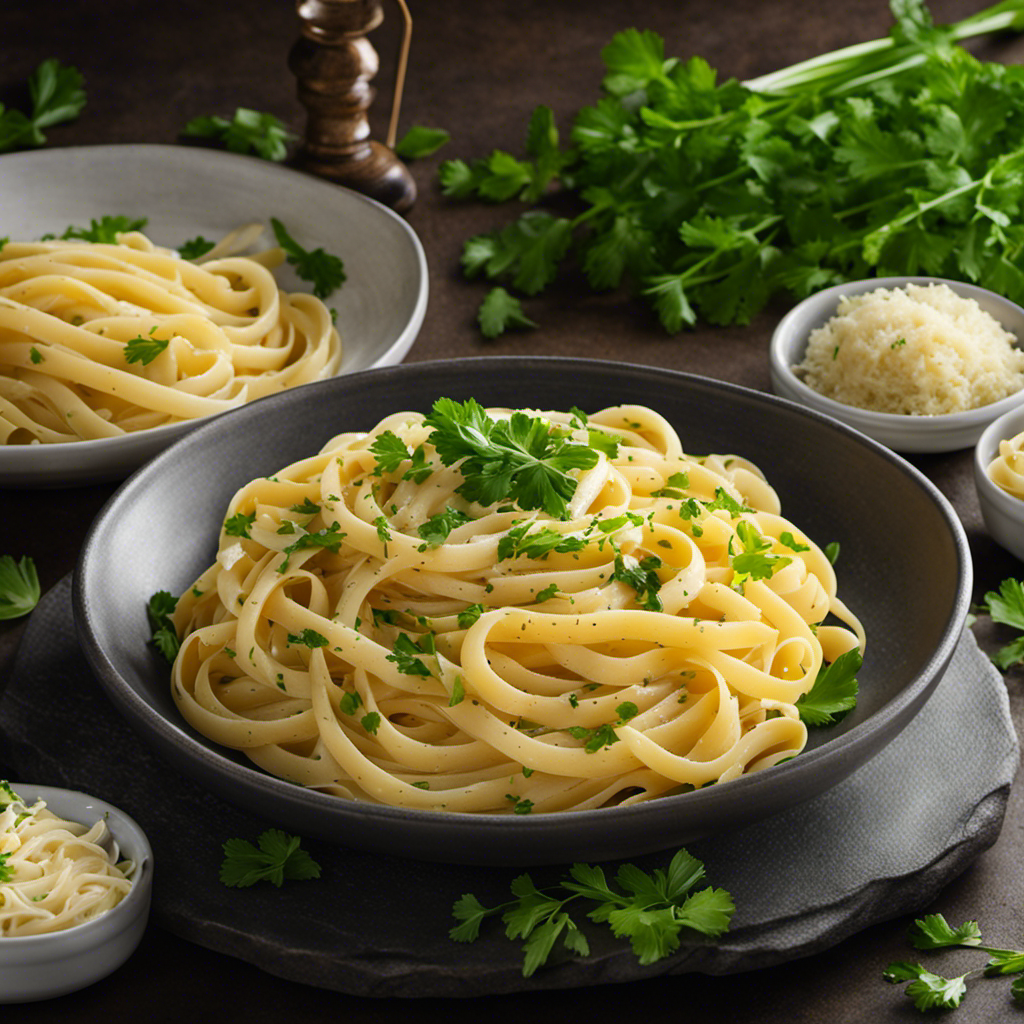
I am going to reveal to you the secret to making the most delicious butter garlic pasta you have ever tried.
Get ready to indulge in a symphony of flavors as tender pasta gets enveloped in a rich, velvety butter garlic sauce.
This recipe is simple yet sophisticated, perfect for impressing guests or treating yourself to a truly decadent meal.
So grab your apron and let’s dive into the magic of homemade butter garlic pasta.
Trust me, you won’t be able to resist.
Key Takeaways
- Choose long and thin pasta like spaghetti or linguine for the best texture.
- Cook the pasta al dente to prevent mushiness and allow the sauce to cling to the strands.
- Prepare a well-seasoned and fragrant garlic butter sauce with sautéed minced garlic and optional herbs and spices.
- Combine the cooked pasta with the simmered sauce, ensuring every strand is coated, and garnish with Parmesan cheese and parsley.
Choosing the Right Pasta
I’ll pick out the perfect type of pasta for my butter garlic pasta. When it comes to choosing the right pasta, there are so many options to consider. Different types of pasta shapes can greatly impact the overall texture and taste of the dish.
For a butter garlic pasta, I’d opt for a long and thin pasta shape like spaghetti or linguine. These types of pasta allow the butter garlic sauce to cling onto the strands, ensuring each bite is full of flavor.
Additionally, the importance of cooking the pasta until it’s al dente can’t be understated. Al dente pasta has a slight bite to it, providing a satisfying texture and preventing it from becoming mushy when combined with the butter garlic sauce.
Preparing the Garlic Butter Sauce
To start, I’ll heat up the olive oil in a skillet and sauté the minced garlic until it becomes fragrant. This step is crucial as it will infuse the sauce with a rich, savory flavor.
Once the garlic is golden and aromatic, I’ll enhance the garlic butter sauce by adding a handful of fresh herbs, such as chopped parsley or basil. These herbs not only add a burst of freshness but also contribute to the overall visual appeal of the dish.
Next, I’ll pour in a splash of white wine to the garlic butter sauce. The wine adds a subtle tanginess and complexity that elevates the flavors. This step is optional, but it truly takes the sauce to another level.
With the garlic butter sauce now perfectly seasoned and fragrant, it’s time to move on to boiling the pasta.
Boiling the Pasta
Once the water reaches a rolling boil, I add a generous amount of salt before adding the pasta. Achieving the perfect al dente texture is essential for a delicious butter garlic pasta. I carefully follow the instructions on the pasta package, cooking it for the recommended time minus a minute or two. This ensures that the pasta is cooked, but still firm to the bite.
To add a twist to the traditional garlic butter pasta, I sometimes incorporate a variety of herbs and spices into the boiling water. A pinch of red pepper flakes adds a subtle kick, while a handful of fresh basil leaves brings a refreshing aroma. These additions elevate the flavors and take the dish to a whole new level.
Cooking the Garlic Butter Sauce
While simmering the sauce, I stir in a knob of butter until it melts and blends seamlessly with the other ingredients. This step is crucial for creating a rich and flavorful garlic butter sauce that will elevate your pasta dish to new heights.
Here are three cooking techniques and flavor variations that you can experiment with to enhance the taste of your butter garlic pasta:
-
Sautéing the garlic: Instead of simply adding minced garlic to the sauce, try sautéing it in the butter until fragrant and golden brown. This will bring out the natural sweetness and depth of flavor in the garlic.
-
Adding herbs and spices: To take your sauce to the next level, consider incorporating herbs like parsley or basil, and spices like red pepper flakes or black pepper. These additions will add complexity and a touch of heat to your butter garlic pasta.
-
Using flavored butter: If you want to get creative with your flavor profile, try using flavored butter. You can find a wide variety of options at the grocery store or make your own by mixing in herbs, spices, or even cheese. This will infuse your sauce with a unique and delicious taste.
Combining the Pasta and Sauce
After the sauce has simmered to perfection, I pour it over the cooked pasta and toss until every strand is coated in the creamy goodness.
The combination of the rich butter and aromatic garlic creates a delectable flavor that’s hard to resist.
To enhance the dish even further, I like to garnish it with a sprinkle of freshly grated Parmesan cheese and a handful of chopped parsley. This adds a touch of freshness and brings out the flavors of the sauce.
As for serving suggestions, this butter garlic pasta pairs well with a simple green salad or some crusty garlic bread on the side.
For variations and substitutions, you can experiment with different types of pasta, such as spaghetti or fettuccine, and add in ingredients like sautéed mushrooms or grilled chicken for added protein.
The possibilities are endless, but one thing is for sure: this butter garlic pasta is a crowd-pleaser that will leave everyone wanting more.
Frequently Asked Questions
How Can I Make This Recipe Vegan-Friendly?
To make this recipe vegan-friendly, you can use vegan substitutes for butter, such as plant-based margarine or coconut oil. Additionally, opt for dairy-free options like almond milk or cashew cream instead of regular milk or cream.
Can I Use Gluten-Free Pasta for This Recipe?
Sure, you can use gluten-free pasta for this recipe. Just remember to follow the cooking instructions for gluten-free pasta and consider alternatives like rice or quinoa pasta for a delicious, gluten-free version.
Can I Substitute Olive Oil for Butter in the Garlic Butter Sauce?
Substituting olive oil or vegan butter in the garlic butter sauce can alter the taste and texture of the dish. Olive oil adds a rich, fruity flavor, while vegan butter provides a creamy and buttery texture.
How Can I Make This Dish Spicier?
To make this dish spicier, there are several ways to add heat. You can incorporate hot chili flakes, spicy red pepper sauce, or even diced jalapeños. Another alternative to garlic could be using ginger for a flavorful twist.
Can I Add Vegetables or Protein to This Pasta Dish?
Adding vegetables and protein to this pasta dish is a great idea. It not only enhances the nutritional value but also adds texture and flavor. I recommend sautéing some bell peppers and adding cooked chicken for a delicious and balanced meal.
Conclusion
In conclusion, making butter garlic pasta is a simple yet delicious dish that can be enjoyed by everyone.
The rich and creamy garlic butter sauce perfectly coats the al dente pasta, creating a mouthwatering combination of flavors.
This recipe allows you to indulge in a culinary experience that’s both satisfying and comforting, like a warm embrace on a chilly evening.
So why not give it a try and treat yourself to a delightful meal?
From sneaky childhood butter licks to penning some of our most popular articles, Jamie’s journey with butter has been lifelong. His culinary background gives him a unique perspective, allowing him to craft mouthwatering articles that educate and tantalize equally. Jamie’s travel adventures revolve around finding the world’s best buttery treats when he isn’t writing.
Recipes & Culinary Uses
Easy Steps to Make Butter from Raw Milk Using a Mixer

As I immerse myself in the realm of culinary exploration, I came across a hidden treasure: crafting butter from raw milk using a mixer. With just a few basic ingredients and my reliable mixer, I unveiled the key to producing smooth, homemade butter that would impress any chef.
In this article, I will guide you through the precise steps, from gathering the ingredients to storing the final product. Get ready to churn and savor the rich rewards of your own creation.
Let’s butter up!
Key Takeaways
- Choose a mixer with a powerful motor and sturdy construction
- Strain and pasteurize the raw milk before churning
- Use a high-speed setting on the mixer for faster butter formation
- Store homemade butter in airtight containers to maintain flavor and freshness
Gathering the Ingredients and Equipment
I’m gathering the ingredients and equipment needed to make butter from raw milk in my mixer.
To ensure a successful butter-making process, it’s crucial to choose the right mixer. Look for a mixer with a powerful motor and a sturdy construction that can handle the thick consistency of the cream. A high-speed setting is also desirable to expedite the churning process.
When it comes to sourcing raw milk, it’s important to prioritize safety and quality. Look for local farms or dairies that follow strict hygiene practices and ensure the cows are healthy and well-cared for. Freshness is key, so opt for milk that has been recently produced and stored properly.
Preparing the Raw Milk for Churning
To start preparing the raw milk for churning, I’ll first need to strain out any impurities. This ensures that the milk is clean and safe for consumption.
Before churning, it’s important to pasteurize the raw milk to eliminate any harmful bacteria that may be present. Pasteurization involves heating the milk to a specific temperature and holding it there for a set period of time. This process helps to destroy any potential pathogens without significantly altering the taste or nutritional composition of the milk.
Once the raw milk is pasteurized, there are different methods of churning it into butter. One method involves using a mixer, which agitates the milk until the fat globules separate from the liquid, forming butter.
Churning the Raw Milk in the Mixer
Using a high-speed setting, I’ll let the mixer agitate the milk until the fat globules separate and butter forms. The speed of the mixer plays a crucial role in the churning process. A higher speed will help the fat globules to separate more quickly, resulting in butter formation. The churning time will vary depending on the mixer speed and the amount of milk being churned. It is important to monitor the process closely to avoid over-churning, which can lead to a grainy texture. To give you an idea of the correlation between mixer speed and churning time, here is a table that summarizes the approximate time required for butter formation at different speeds:
| Mixer Speed | Churning Time (minutes) |
|---|---|
| Low | 20-30 |
| Medium | 15-20 |
| High | 10-15 |
| Very High | 5-10 |
| Turbo | 2-5 |
Separating the Butter From the Buttermilk
After the churning process, I strain the mixture through a fine-mesh sieve to separate the butter from the buttermilk. The creamy liquid slowly drips down, leaving behind the beautiful golden butter. It’s a delicate process, requiring patience and precision.
As I watch the buttermilk flow through the sieve, I can’t help but appreciate the benefits of using raw milk for making butter. The rich and complex flavors of raw milk add depth and character to the final product. It’s like tasting a piece of the farm, with its grassy undertones and hints of sweetness.
To further enhance the butter’s taste, there are various methods for flavoring homemade butter. From the simplicity of sprinkling salt to the creativity of adding herbs and spices, the possibilities are endless.
Storing and Using Your Homemade Butter
When storing my homemade butter, I prefer to use airtight containers to keep it fresh and prevent any unwanted odors from seeping in. It’s important to protect the butter’s flavor and texture, as well as extend its shelf life. Additionally, I like to experiment with different flavors to add a unique twist to my butter. Some creative ways to flavor homemade butter include incorporating herbs like rosemary or thyme, adding spices like cinnamon or garlic powder, or mixing in sweet ingredients like honey or maple syrup. This allows me to customize my butter based on my preferences and the dishes I plan to use it in. Speaking of which, homemade butter has a multitude of uses in cooking and baking. It can be spread on toast, melted over vegetables, used as a base for sauces, or incorporated into pastry dough for flakier results. The possibilities are endless!
| Flavor | Ingredients | Recommended Uses |
|---|---|---|
| Herb-infused | Rosemary, thyme | Mashed potatoes, roasted vegetables |
| Spiced | Cinnamon, garlic powder | Toast, pancakes |
| Sweet | Honey, maple syrup | Baked goods, waffles |
Frequently Asked Questions
How Long Does It Take for the Raw Milk to Turn Into Butter in the Mixer?
To speed up the process of turning raw milk into butter in a mixer, you can increase the speed and duration of mixing. It is not possible to make butter in a mixer without using raw milk.
Can I Use Pasteurized Milk Instead of Raw Milk for Making Butter in a Mixer?
Using raw milk instead of pasteurized milk for making butter in a mixer has several benefits. It enhances the flavor and nutritional value of the butter. To achieve the best consistency, ensure the milk is fresh and at room temperature before churning.
What Is the Ideal Temperature for the Raw Milk Before Churning It in the Mixer?
The ideal temperature for raw milk before churning it in the mixer is around 50-55°F. This ensures proper fat separation and reduces churning time. It’s crucial to maintain the correct temperature for the best results.
Can I Add Flavorings or Herbs to the Butter While Churning It in the Mixer?
Yes, you can add flavorings or herbs to the butter while churning it in the mixer. This is a great way to incorporate flavor into homemade butter and experiment with different tastes.
Can I Use a Hand Mixer Instead of a Stand Mixer to Churn the Raw Milk Into Butter?
Using a hand mixer for churning raw milk into butter has its pros and cons. It can be more convenient and easier to handle, but may take longer and require more effort compared to a stand mixer. Other methods without a mixer include shaking in a jar or using a food processor.
Conclusion
In conclusion, making butter from raw milk in a mixer is a simple and rewarding process. By following the steps outlined above and using the right ingredients and equipment, you can transform fresh raw milk into delicious homemade butter.
Remember, practice makes perfect, so don’t be discouraged if your first attempt isn’t perfect. With a little patience and perseverance, you’ll be churning out creamy butter in no time, and soon you’ll be able to spread it on toast and enjoy the fruits of your labor.
Diana’s meticulous nature and editorial prowess set the gold standard for our content. With over a decade in the culinary and publishing industries, her guidance ensures that every article perfectly blends information and entertainment. A culinary experimenter, Diana loves whipping up new butter-based concoctions in her kitchen.
Recipes & Culinary Uses
Make Rich Butter from Raw Milk
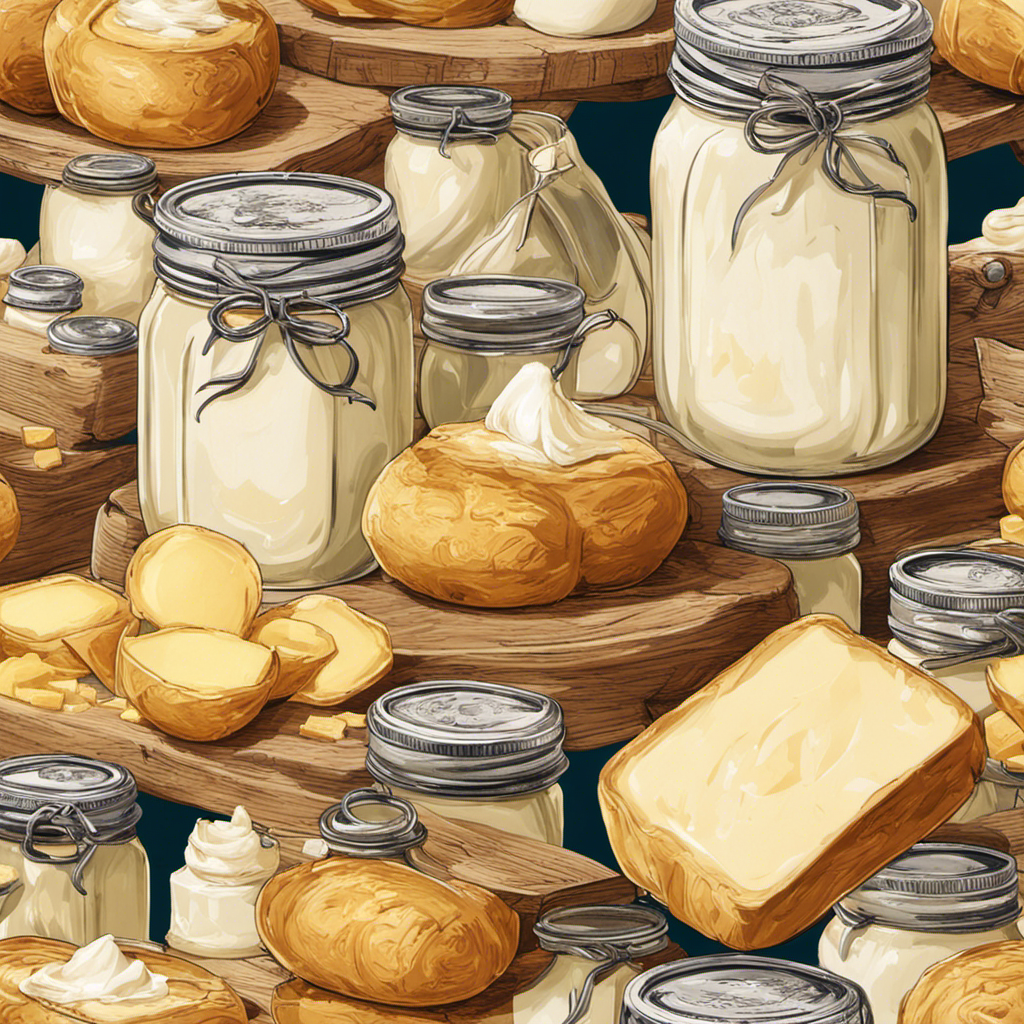
Hey! Have you ever thought about how to turn raw milk into homemade butter? Look no further, I’ve got the solution for you.
In this article, I’ll take you through the step-by-step process of turning that creamy goodness into delicious homemade butter.
We’ll explore the benefits of using raw milk, learn how to separate the cream, and even discover different flavors you can infuse into your butter.
So, grab your apron and let’s get churning!
Key Takeaways
- Raw milk contains essential vitamins, minerals, and enzymes that are destroyed during pasteurization.
- Separating the cream from raw milk can be done through gravity separation, centrifugal separation, or cold separation.
- Churning the cream into butter can be done through hand churning, using a stand mixer with a whisk attachment, or using a food processor with a blade attachment.
- Washing and storing the freshly made butter involves cleaning the butter container and preserving its freshness by wrapping it tightly in wax paper or using an airtight container.
Understanding the Benefits of Raw Milk
Raw milk has numerous health benefits that are not found in pasteurized milk. Understanding the nutritional value of raw milk is important for those seeking a natural and wholesome source of nutrients.
Contrary to popular belief, raw milk is not a dangerous product when handled and consumed properly. In fact, it contains essential vitamins, minerals, and enzymes that are destroyed during the pasteurization process.
Raw milk is rich in beneficial bacteria and probiotics, which can support a healthy gut microbiome and enhance digestion. Additionally, raw milk is a good source of bioavailable nutrients such as calcium, protein, and healthy fats.
Debunking myths about raw milk is crucial to prevent misinformation and promote informed choices regarding our food.
Preparing the Raw Milk for Butter Making
To prepare the milk for butter making, it’s important to first skim off the cream. This step is crucial as it allows us to separate the high-fat cream from the milk, which is necessary for obtaining a good quality butter.
Here are three separating techniques to help you achieve the best results:
-
Gravity separation: After allowing the milk to stand undisturbed for a few hours, the cream naturally rises to the top, making it easy to skim off with a spoon or ladle.
-
Centrifugal separation: Using a cream separator machine, the milk is spun at high speeds, causing the heavier cream to separate from the lighter milk. This method is efficient and yields a higher cream quality.
-
Cold separation: By refrigerating the milk overnight, the cream becomes denser and easier to separate. Skimming off the cold cream results in a richer and creamier butter.
Separating the Cream From the Raw Milk
If you want to achieve the best results when separating the cream from the milk, try using gravity separation, centrifugal separation, or cold separation techniques.
Gravity separation involves allowing the milk to sit undisturbed in a container for a period of time, allowing the cream to rise to the top.
Centrifugal separation utilizes a machine that spins the milk at high speeds, forcing the cream to separate from the milk.
Cold separation involves chilling the milk to a low temperature, causing the cream to solidify and separate from the milk.
These techniques are beneficial because consuming raw dairy has numerous health benefits, such as improved digestion, increased nutrient absorption, and enhanced immune function.
Additionally, if you don’t have access to a churn, these separation methods provide alternatives for obtaining cream for making butter.
Churning the Cream Into Butter
Once the cream has separated from the milk, you can start churning it into delicious butter. Churning is the process of agitating the cream until it transforms into butter.
Here are three techniques to help you achieve the perfect consistency:
-
Hand Churning: This traditional method involves using a small churn or jar and physically shaking or rocking it back and forth until the cream turns into butter.
-
Stand Mixer: If you have a stand mixer with a whisk attachment, you can use it to churn the cream. Start at a low speed and gradually increase until the butter forms.
-
Food Processor: Another option is to use a food processor with a blade attachment. Pulse the cream until it separates into butter and buttermilk.
Troubleshooting common butter making problems:
- If the cream isn’t thickening, ensure it is at the right temperature (around 50-55°F) and give it more time to churn.
- If the butter is too soft, refrigerate it for a while before churning again.
- If the butter is too hard, let it soften at room temperature or add a small amount of buttermilk to adjust the consistency.
After churning the cream into butter, it’s time to move on to the next step of washing and storing the freshly made butter.
Washing and Storing the Freshly Made Butter
When it comes to washing and storing freshly made butter, there are a few key points to consider.
First, cleaning the butter container is essential to maintain the quality of the butter. I recommend using warm soapy water and a soft sponge to remove any residue before drying it thoroughly.
Second, preserving the butter’s freshness is crucial to prolong its shelf life. To do this, I suggest wrapping the butter tightly in wax paper or placing it in an airtight container to protect it from air and odors.
Lastly, it’s important to store butter at the proper temperature. The recommended storage temperature for butter is between 32-40°F (0-4°C), as this helps to maintain its texture and prevent spoilage.
Cleaning the Butter Container
Before cleaning the butter container, make sure to remove any leftover butter residue. Cleaning the butter container is essential to maintain its freshness and prevent any cross-contamination. Here are three effective cleaning techniques to ensure a clean and sanitized container:
-
Soak in hot, soapy water: Fill the container with hot water and add a few drops of dish soap. Let it sit for a few minutes to loosen any residue, then scrub with a sponge or brush.
-
Use vinegar solution: Mix equal parts white vinegar and water in the container. Let it sit for about 15 minutes to dissolve any stubborn residue. Scrub with a sponge or brush, then rinse thoroughly.
-
Bleach solution: Mix 1 tablespoon of bleach with 1 gallon of water. Let the container soak in the solution for 10 minutes, then scrub and rinse well.
Preserving Butter’s Freshness
After cleaning the butter container, the next step is to ensure that the butter stays fresh and maintains its texture for as long as possible. This is important because nobody wants to end up with rancid butter. To preserve the butter’s freshness, there are a few key things you can do. Firstly, storing the butter in an airtight container or wrapping it tightly in wax paper will help prevent it from being exposed to air and developing off flavors. Secondly, keeping the butter refrigerated at a consistent temperature, ideally around 40°F (4°C), will slow down the process of it going rancid. Lastly, if you want to store butter for an extended period of time, freezing it is a great option as it can extend its shelf life for several months. By following these steps, you can enjoy fresh and flavorful butter for all your culinary needs.
| Preserving Butter’s Freshness |
|---|
| Store butter in an airtight container or wrap tightly in wax paper. |
| Refrigerate butter at a consistent temperature of around 40°F (4°C). |
| Freeze butter for extended storage, which can extend its shelf life for several months. |
| Follow these steps to enjoy fresh and flavorful butter for all your culinary needs. |
Recommended Storage Temperature
Storing butter in the refrigerator at a consistent temperature of around 40°F (4°C) helps to maintain its freshness and prevent it from going rancid. Here are three recommended storage methods and the ideal temperature range for butter:
-
Wrap it properly: Use parchment paper or airtight containers to wrap the butter. This will protect it from absorbing odors and prevent it from drying out.
-
Keep it away from light: Exposure to light can cause butter to spoil faster. Store it in a cool, dark place, like the refrigerator’s butter compartment or a covered butter dish.
-
Avoid temperature fluctuations: Butter can easily absorb flavors and odors from other foods in the fridge. To maintain its quality, store it away from strong-smelling foods and make sure the temperature remains constant.
Following these recommended storage methods and keeping the butter at the ideal temperature range will help to preserve its freshness and taste for longer periods.
Using Leftover Buttermilk in Recipes
You can easily use leftover buttermilk in recipes to add a tangy flavor. Buttermilk is a versatile ingredient that can enhance the taste and texture of various baked goods. It’s a great substitute for regular milk in recipes because it adds a unique tanginess and richness. Here are some creative uses for leftover buttermilk in baking:
| Row | Buttermilk | Recipe | Result |
| 1 | Pancakes | Fluffy and | Light and |
| tender texture | fluffy pancakes | ||
| 2 | Biscuits | Tender and | Flaky and |
| flaky texture | buttery biscuits | ||
| 3 | Cakes | Moist and | Moist and |
| tender texture | tender cakes | ||
| 4 | Fried chicken | Crispy and | Juicy and |
| flavorful coating | flavorful chicken |
Exploring Variations and Flavors in Homemade Butter
When it comes to homemade butter, there are endless possibilities for adding unique flavors and enhancing its taste.
One way to do this is through unique butter infusions, where you can mix in various ingredients like garlic, herbs, or even fruit zest to create a personalized flavor profile.
Another option is to enhance the taste of your homemade butter by incorporating herbs such as rosemary, thyme, or basil, which can add a delightful aroma and taste.
Lastly, experimenting with flavored salts like smoked sea salt or truffle salt can take your butter to a whole new level, adding a burst of flavor that will elevate any dish.
Unique Butter Infusions
To add unique flavors to your butter, try infusing it with herbs or spices. Butter infusion techniques offer a creative way to elevate the taste of your homemade butter. Here are three ideas to get you started:
-
Garlic and Herb Butter: Melt your butter, then add minced garlic and chopped fresh herbs like rosemary, thyme, or parsley. Let the flavors infuse for a few hours before refrigerating.
-
Citrus Zest Butter: Grate the zest of an orange, lemon, or lime into your softened butter. Mix well and let it sit in the fridge for a while to let the citrus flavors infuse.
-
Spiced Butter: Add a pinch of your favorite spices, such as cinnamon, nutmeg, or cardamom, to your softened butter. Mix thoroughly and let it sit in the fridge to develop the flavors.
Enhancing Taste With Herbs
Adding herbs to your butter is a simple and effective way to enhance the taste of your culinary creations. Not only does it add a burst of flavor, but it also adds a touch of freshness and complexity to your dishes. Experimenting with different herbal blends can elevate your butter to a whole new level. Whether you prefer a savory blend of rosemary and thyme or a more exotic combination of cilantro and lime, the possibilities are endless. To help you get started, here is a table showcasing some popular herb and spice combinations that you can try in your butter:
| Herb/Spice | Flavor Profile | Best Pairings |
|---|---|---|
| Rosemary | Earthy, piney | Potatoes, lamb |
| Basil | Sweet, peppery | Tomatoes, mozzarella |
| Dill | Fresh, tangy | Fish, cucumbers |
| Cinnamon | Warm, sweet | Apples, baked goods |
Experimenting With Flavored Salts
After experimenting with herbs to enhance the taste of my homemade butter, I decided to take my flavor exploration to the next level by experimenting with flavored salts. Flavored salts can add a unique and exciting twist to butter, elevating its taste and making it even more delicious.
Here are three ways I incorporated different salts into my flavored butter recipes:
-
Smoked Salt Butter: I mixed smoked salt into softened butter, creating a smoky and savory spread that pairs perfectly with grilled meats and vegetables.
-
Truffle Salt Butter: By combining truffle salt with butter, I created a luxurious and indulgent spread that adds a hint of earthy and aromatic flavor to any dish.
-
Citrus Salt Butter: I zested some fresh citrus fruits and mixed the zest with sea salt before incorporating it into butter. The result was a bright and tangy butter that adds a burst of freshness to baked goods and seafood.
Frequently Asked Questions
Can I Make Butter From Pasteurized Milk?
Yes, you can make butter from pasteurized milk. It’s a simple process of churning the cream until it separates into butter and buttermilk. Homemade butter can be healthier than store-bought due to its freshness and lack of additives.
How Long Does It Take to Separate the Cream From the Raw Milk?
Separating cream from raw milk depends on various factors, such as temperature and milk fat content. Once separated, the cream can be churned into butter. The churning process can take anywhere from 10 to 30 minutes.
Can I Use an Electric Mixer Instead of a Churn to Make Butter?
Yes, you can use an electric mixer to make butter. However, it’s important to note that the process may differ slightly between churning raw milk and pasteurized milk.
How Long Can I Store Freshly Made Butter?
Freshly made butter can be stored in the refrigerator for up to two weeks. However, its shelf life can be extended by freezing it. Proper storage is essential to maintain its freshness and quality.
What Other Uses Are There for Leftover Buttermilk Besides Using It in Recipes?
Leftover buttermilk can be used in pancakes, biscuits, or even as a marinade for fried chicken. As for alternative methods for making butter, you can also use heavy cream and a mixer.
Conclusion
In conclusion, making butter from raw milk is a delightful and rewarding process. The benefits of raw milk are numerous, as it contains valuable enzymes and nutrients that are lost during pasteurization.
By separating the cream from the raw milk and churning it vigorously, you can easily transform it into creamy and delicious homemade butter.
Don’t forget to wash and store the butter properly to ensure its freshness. And don’t discard the leftover buttermilk! It can be used in various recipes to add flavor and moisture.
So, grab some raw milk and start your butter-making adventure today!
Diana’s meticulous nature and editorial prowess set the gold standard for our content. With over a decade in the culinary and publishing industries, her guidance ensures that every article perfectly blends information and entertainment. A culinary experimenter, Diana loves whipping up new butter-based concoctions in her kitchen.
-
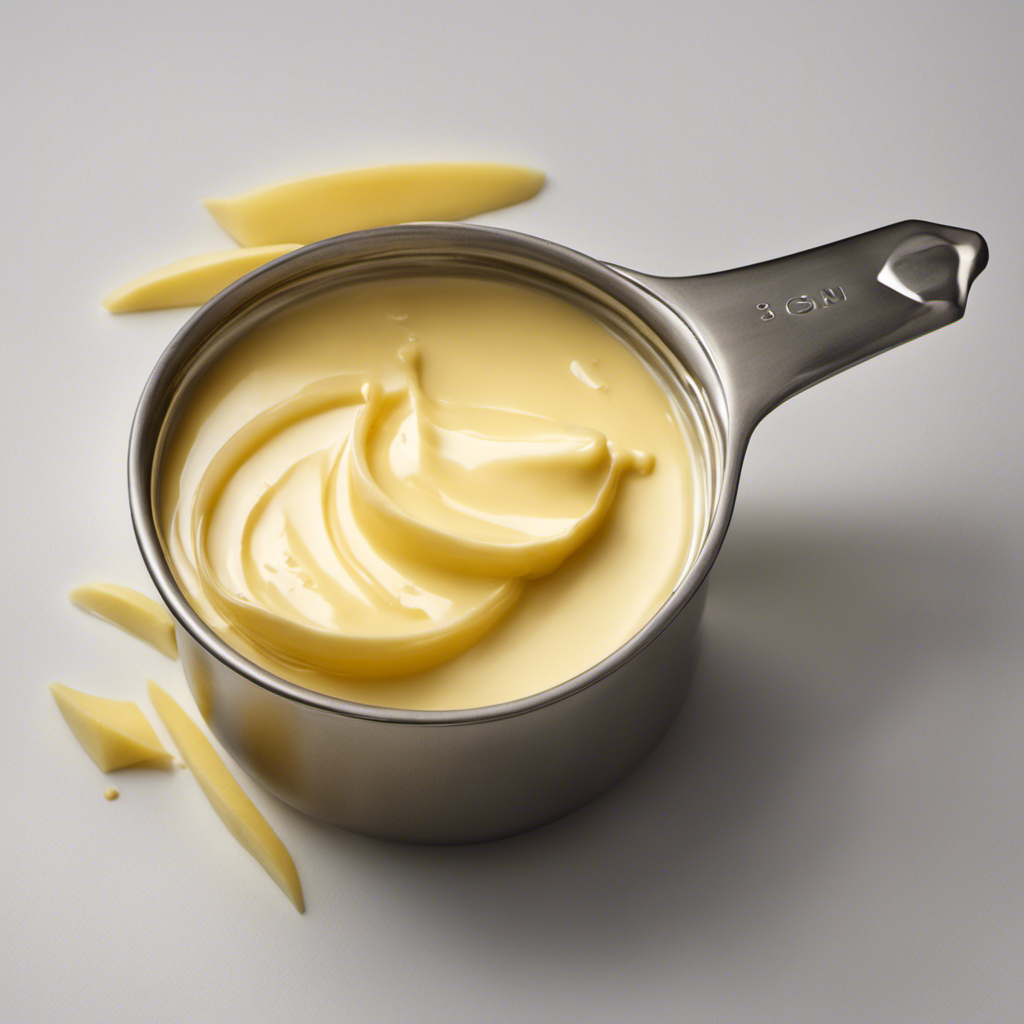
 Butter Tips and Tricks3 months ago
Butter Tips and Tricks3 months agoHow Many Tablespoons in 2/3 Cup of Butter?
-
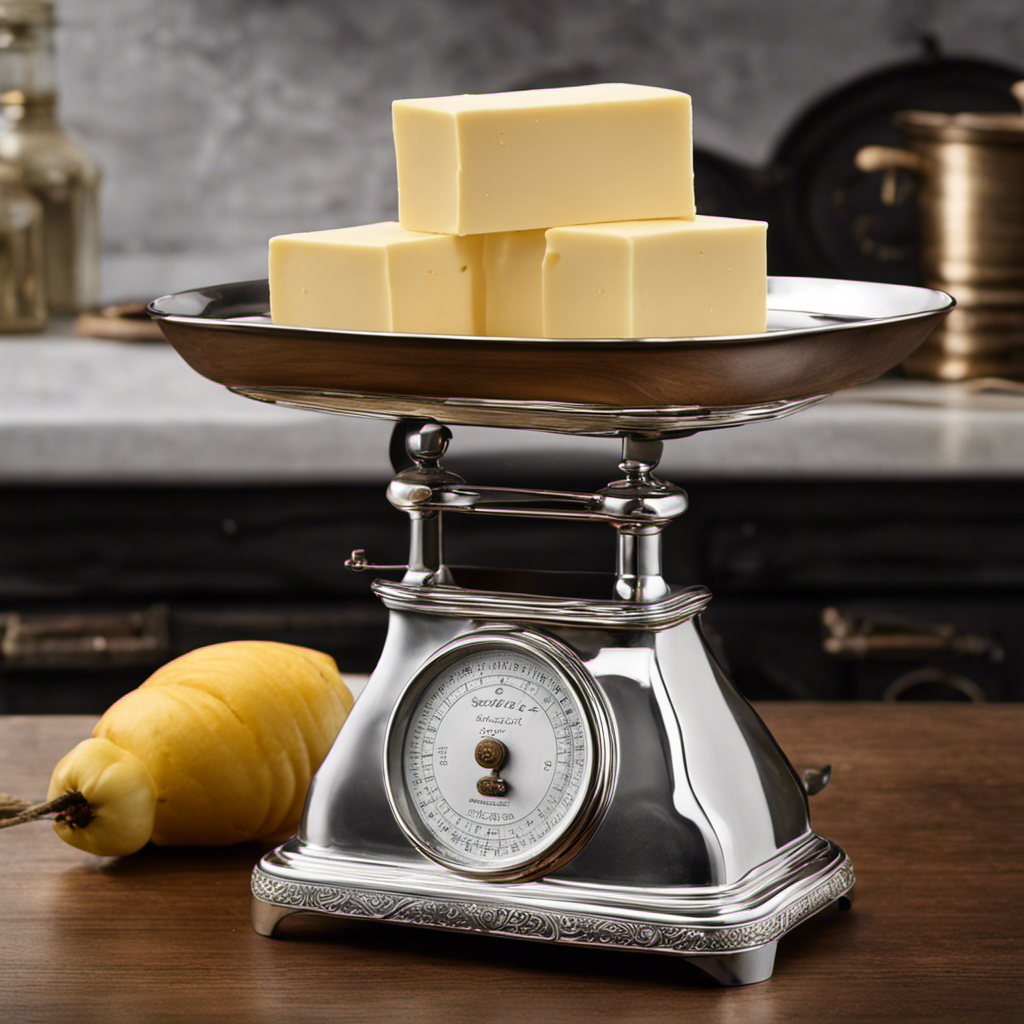
 Butter Tips and Tricks3 months ago
Butter Tips and Tricks3 months agoConverting 3/4 Cup of Butter to Sticks: How Many Sticks?
-
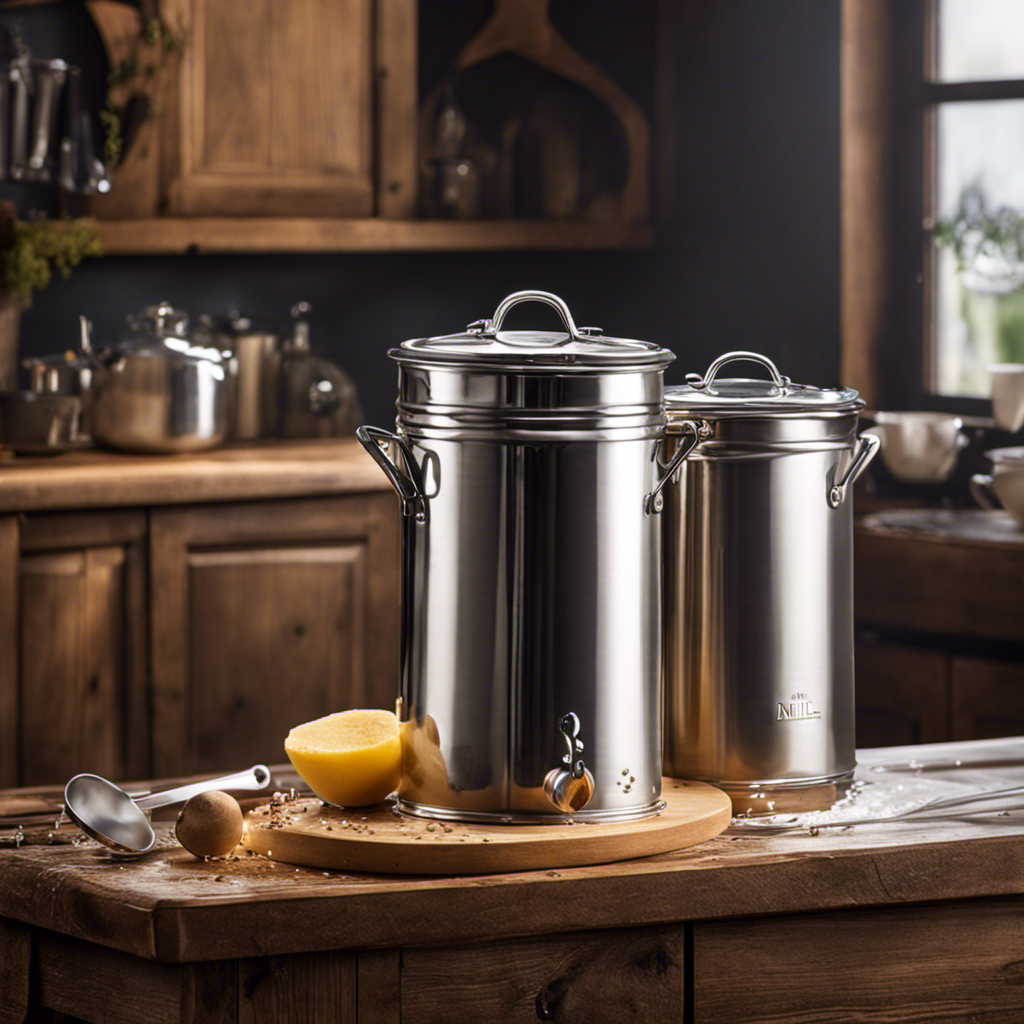
 Recipes & Culinary Uses3 days ago
Recipes & Culinary Uses3 days agoHomemade Butter Making at Home with Fresh Milk
-
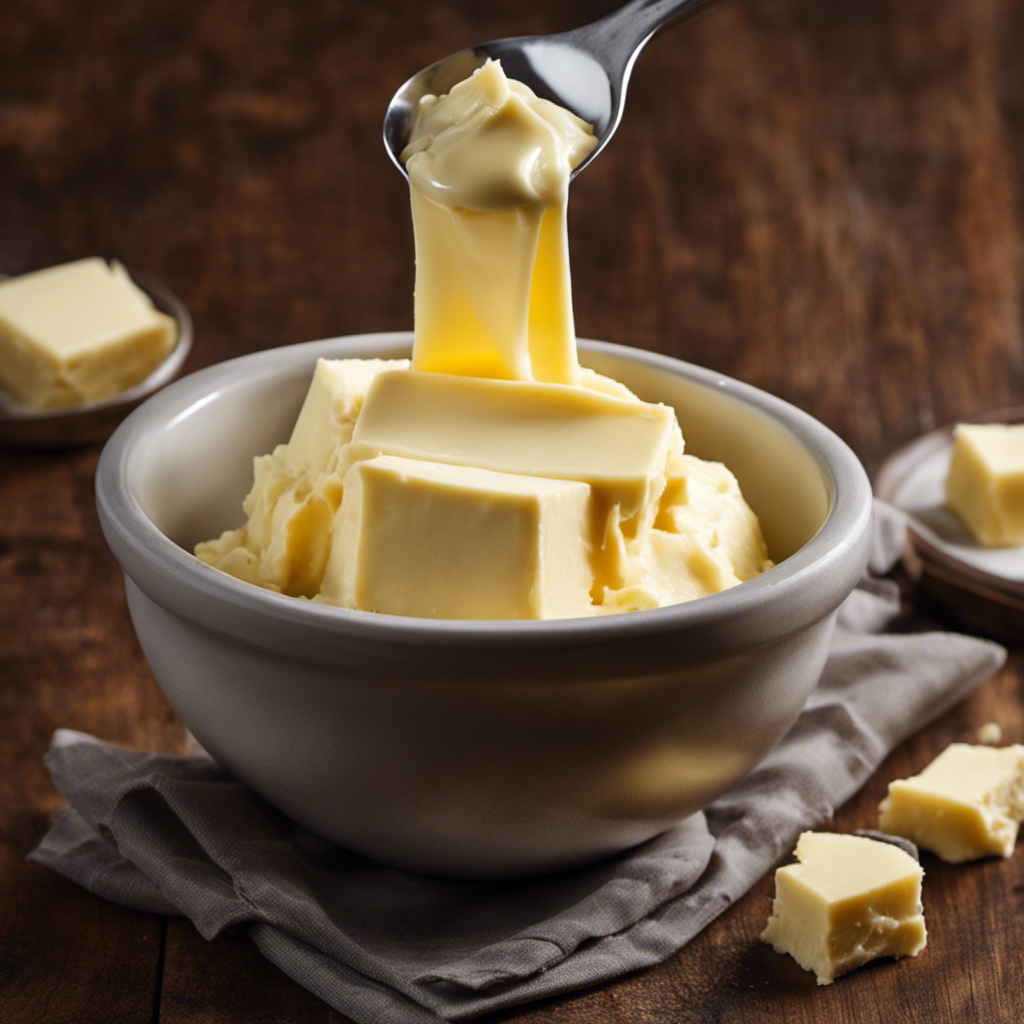
 Butter Tips and Tricks2 months ago
Butter Tips and Tricks2 months agoHow Many Tablespoons of Butter Are in 3/4 Cup?
-

 Recipes & Culinary Uses1 month ago
Recipes & Culinary Uses1 month ago10 Steps to Cook Delicious Dried Butter Beans
-
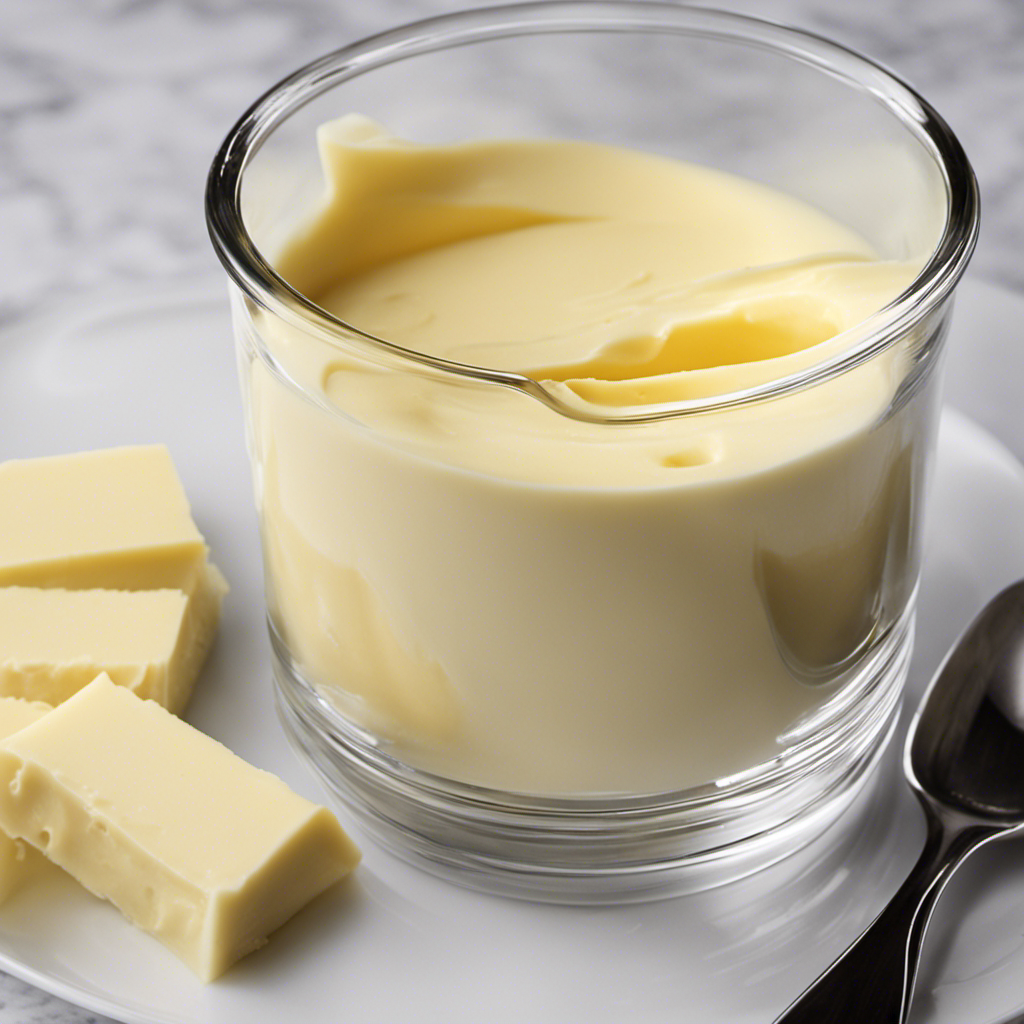
 Recipes & Culinary Uses1 month ago
Recipes & Culinary Uses1 month agoHow Many Tablespoons of Butter in 3/4 Cup: A Simple Guide
-

 Butter Tips and Tricks2 months ago
Butter Tips and Tricks2 months agoHow Many Tablespoons of Butter in 1/4 Cup: A Simple Guide
-
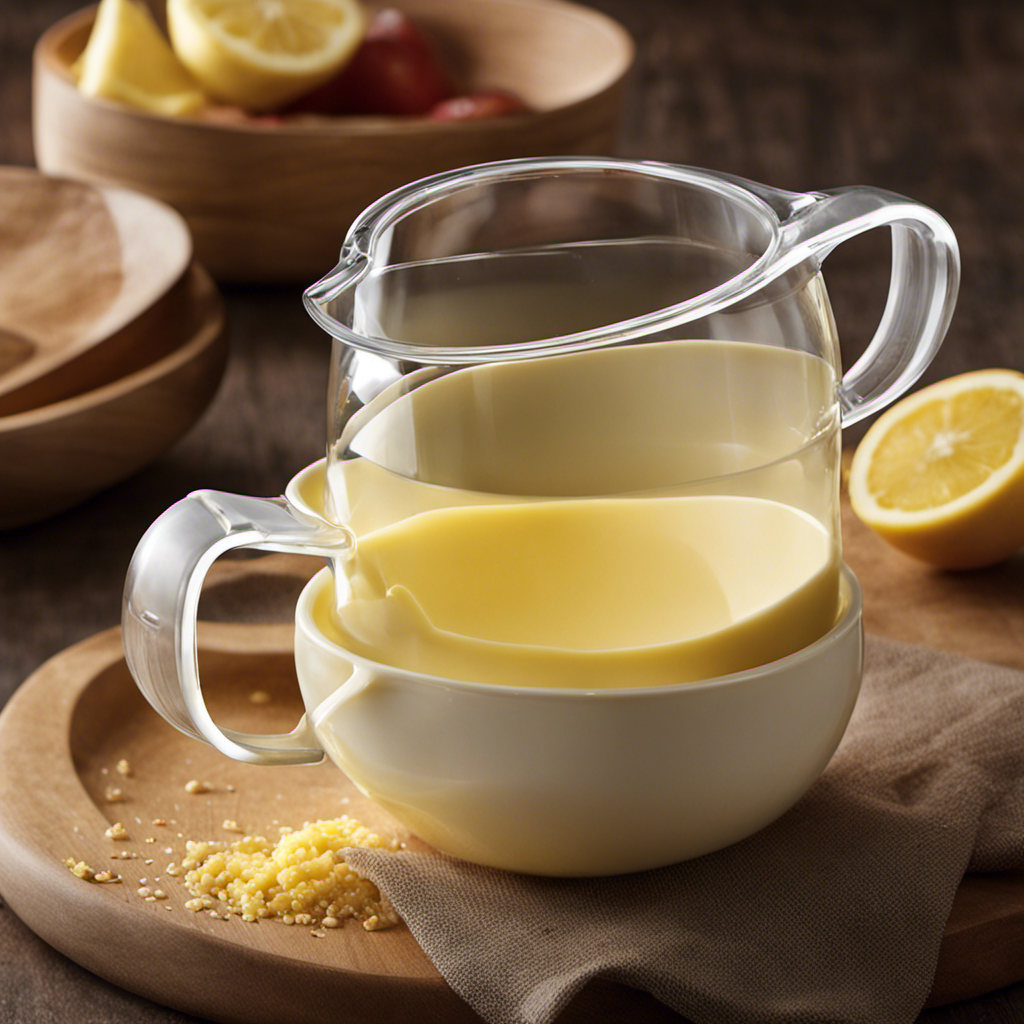
 Butter Tips and Tricks2 months ago
Butter Tips and Tricks2 months agoHow Many Tablespoons of Butter in 1/3 Cup: A Simple Guide














